课程链接:http://video.jessetalk.cn/course/explore
良心课程,大家一起来学习哈!
任务22:课程介绍
- 1.HTTP 处理过程
- 2.WebHost 的配置与启动
- 3.Middleware 与管道
- 4.Routing MiddleWare 介绍
任务23:Http请求的处理过程

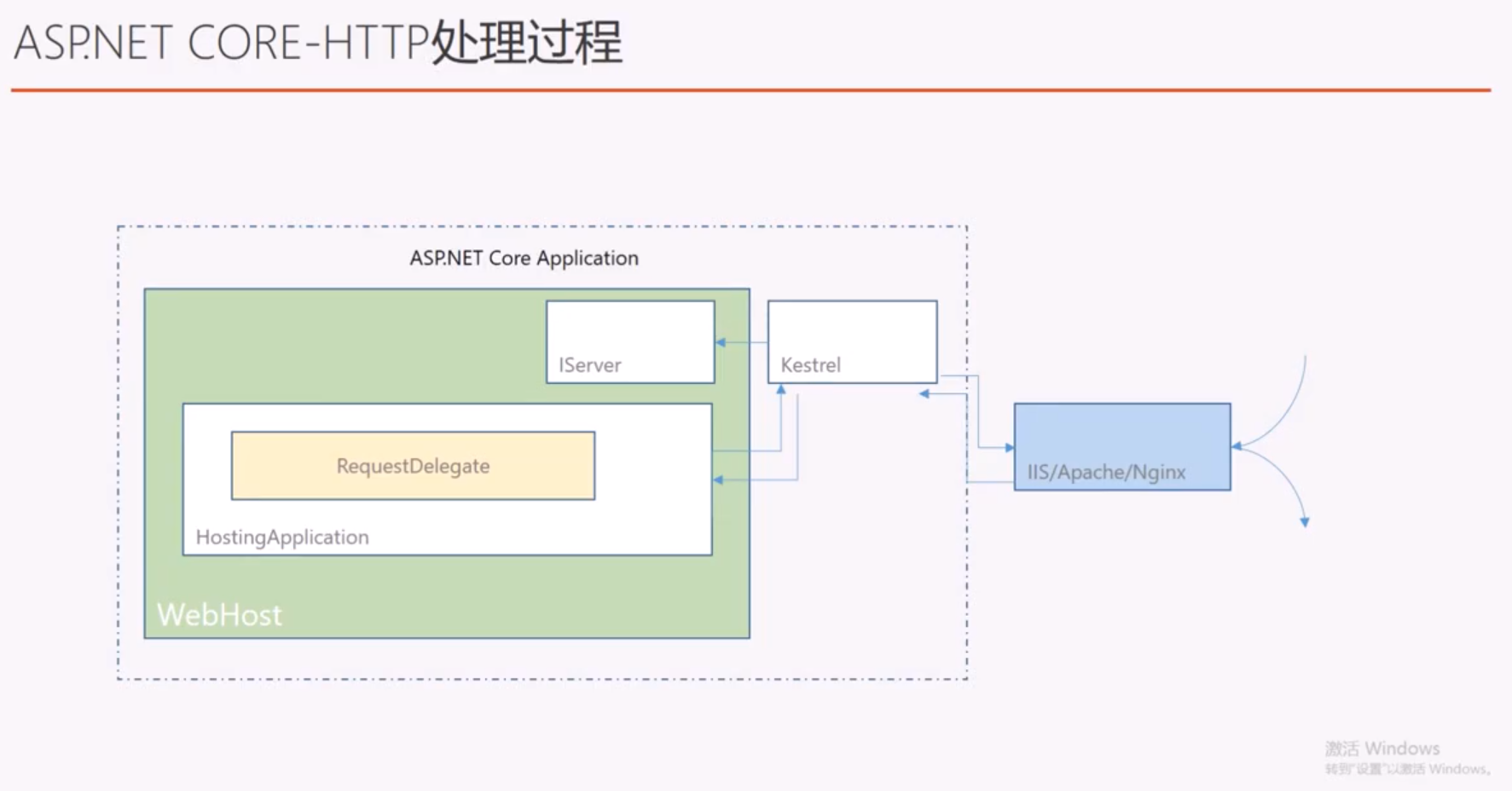
任务24:WebHost的配置
dotnet new webProgram.cs
public static IWebHostBuilder CreateWebHostBuilder(string[] args) =>
WebHost.CreateDefaultBuilder(args)
.ConfigureAppConfiguration(configureDelegate=>{
configureDelegate.AddJsonFile("settings.json");
configureDelegate.AddCommandLine(args);
})
.UseUrls("http://localhost:5001")
.UseStartup<Startup>();settings.json
{
"ConnectionStrings":{
"DefaultConnection":"Server=...;Database=...;"
}
}Startup.cs
using Microsoft.Extensions.Configuration;
public void Configure(IApplicationBuilder app, IHostingEnvironment env, IConfiguration configuration)
{
if (env.IsDevelopment())
{
app.UseDeveloperExceptionPage();
}
app.Run(async (context) =>
{
// await context.Response.WriteAsync("Hello World!");
// JsonFile
await context.Response.WriteAsync(configuration["ConnectionStrings:DefaultConnection"]);
// CommandLine
await context.Response.WriteAsync($"name={configuration["name"]}");
});
}任务25:IHostEnvironment和 IApplicationLifetime介绍
Startup.cs
app.Run(async (context) =>
{
await context.Response.WriteAsync($"ContentRootPath = {env.ContentRootPath}");
await context.Response.WriteAsync($"EnvironmentName = {env.EnvironmentName}");
await context.Response.WriteAsync($"WebRootPath = {env.WebRootPath}");
});Startup.cs
// This method gets called by the runtime. Use this method to configure the HTTP request pipeline.
public void Configure(IApplicationBuilder app, IHostingEnvironment env, IConfiguration configuration, IApplicationLifetime applicationLifetime)
{
if (env.IsDevelopment())
{
app.UseDeveloperExceptionPage();
}
applicationLifetime.ApplicationStarted.Register(() =>
{
Console.WriteLine("Started");
});
applicationLifetime.ApplicationStopped.Register(() =>
{
Console.WriteLine("Stopped");
});
applicationLifetime.ApplicationStopped.Register(() =>
{
Console.WriteLine("Stopped");
});
app.Run(async (context) =>
{
await context.Response.WriteAsync($"ContentRootPath = {env.ContentRootPath}");
await context.Response.WriteAsync($"EnvironmentName = {env.EnvironmentName}");
await context.Response.WriteAsync($"WebRootPath = {env.WebRootPath}");
});
}我心中的ASP.NET Core 新核心对象WebHost(一)
我心中的ASP.NET Core 新核心对象WebHost(二)
任务26:dotnet watch run 和attach到进程调试
New Terminal
dotnet new web --name HelloCoreF5 Start Debug
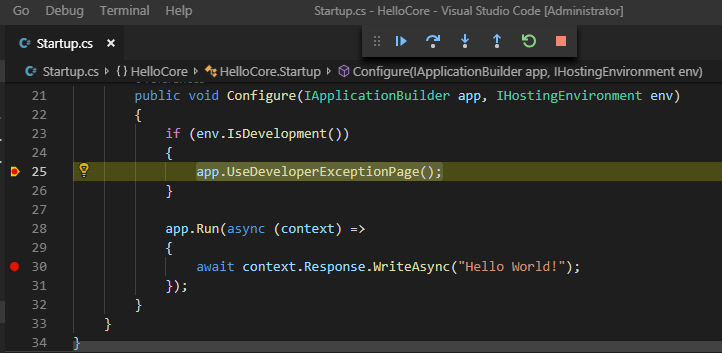
New Terminal
dotnet watch run修改代码保存后会自动重启
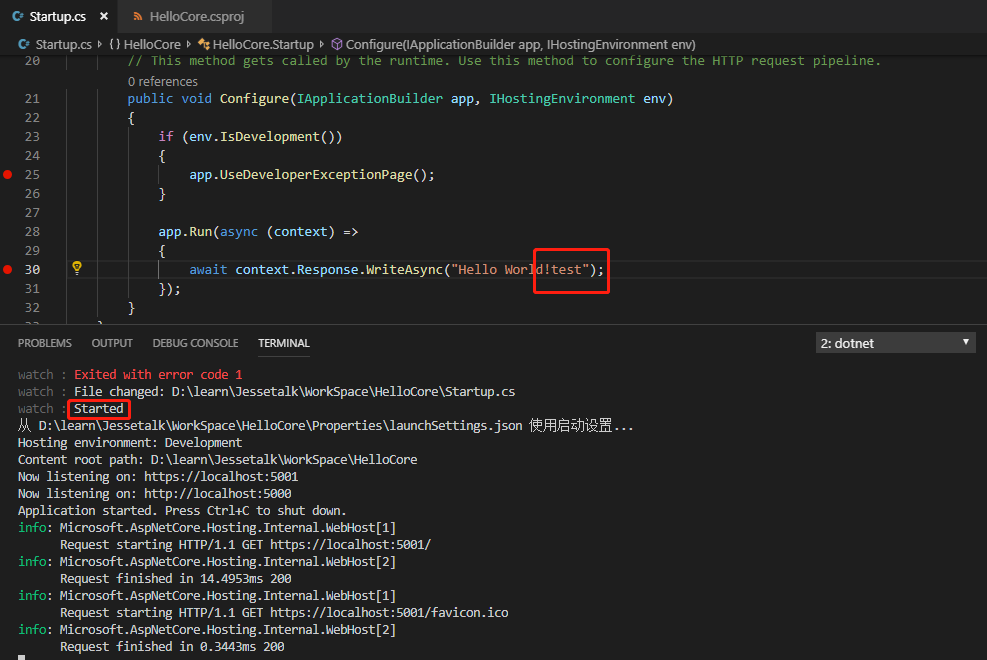
浏览器刷新即可看到更新结果
attach到进程调试
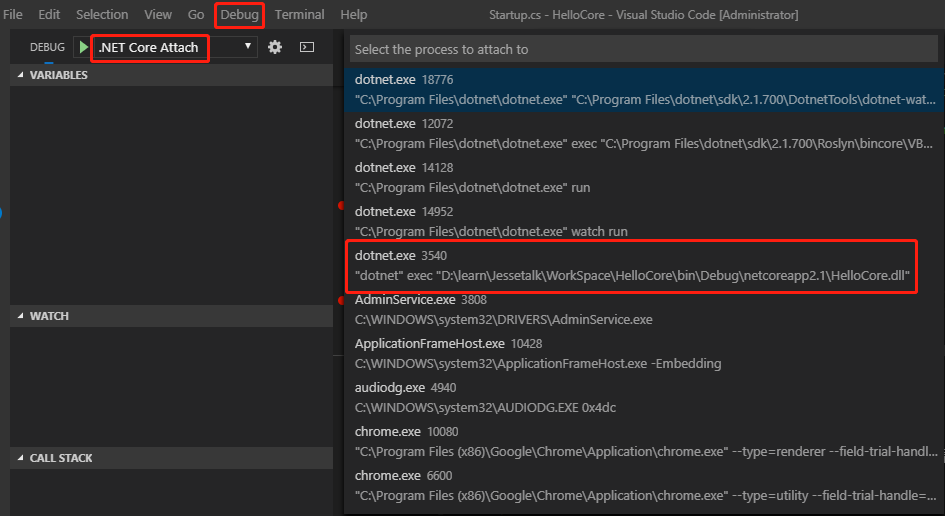
任务27:Middleware管道介绍
- 1.Middleware 与管道的概念
- 2.用 Middleware 来组成管道实践
- 3.管道的实现机制(RequestDelegate 与 ApplicationBuilder)
public class Startup
{
// This method gets called by the runtime. Use this method to add services to the container.
// For more information on how to configure your application, visit https://go.microsoft.com/fwlink/?LinkID=398940
public void ConfigureServices(IServiceCollection services)
{
}
// This method gets called by the runtime. Use this method to configure the HTTP request pipeline.
// IApplicationBuilder用于构建管道
public void Configure(IApplicationBuilder app, IHostingEnvironment env)
{
if (env.IsDevelopment())
{
app.UseDeveloperExceptionPage();
}
// 使用Map构建路由,通过localhost:5000/task访问
app.Map("/task", taskApp=>{
taskApp.Run(async context=>{
await context.Response.WriteAsync("this is a task");
});
});
// 添加一个中间件,传一个名字为next的request delegate
app.Use(async (context,next)=>{
await context.Response.WriteAsync("1: before start...");
await next.Invoke();
});
// 如果不调用next,则管道终止,不会输出"3: start..."
app.Use(next=>{
return (context)=>{
context.Response.WriteAsync("2: in the middle of start..");
return next(context);
};
});
app.Run(async (context) =>
{
await context.Response.WriteAsync("3: start...");
});
}
}任务28:RequestDelegate管道实现思路
- 1.RequestDelegate
- 2.ApplicationBuilder
// 添加一个中间件,传一个名字为next的RequestDelegate
app.Use(async (context,next)=>{
await context.Response.WriteAsync("1: before start...");// 完成自己处理
await next.Invoke();// 调用下一步
});
// 封装一个function交给ApplicationBuilder处理
app.Use(next=>{
return (context)=>{
context.Response.WriteAsync("2: in the middle of start..");
return next(context);
};
});任务29:自己动手构建RequestDelegate管道
新建一个控制台程序
dotnet new console --name MyPipelineusing System;
using System.Threading.Tasks;
namespace MyPipeline
{
public delegate Task RequestDelegate(Context context);
}using System;
using System.Threading.Tasks;
namespace MyPipeline
{
public class Context
{
}
}
using System;
using System.Collections.Generic;
using System.Threading.Tasks;
namespace MyPipeline
{
class Program
{
public static List<Func<RequestDelegate,RequestDelegate>>
_list = new List<Func<RequestDelegate, RequestDelegate>>();
static void Main(string[] args)
{
Use(next=>{
return context=>{
Console.WriteLine("1");
// return next.Invoke(context);
return Task.CompletedTask;// 结束管道调用,只输出1
};
});
Use(next=>{
return context=>{
Console.WriteLine("2");
return next.Invoke(context);
};
});
RequestDelegate end = (Context)=>{
Console.WriteLine("end...");
return Task.CompletedTask;
};
foreach(var middleware in _list)
{
end = middleware.Invoke(end);
}
end.Invoke(new Context());
Console.ReadLine();
}
public static void Use(Func<RequestDelegate,RequestDelegate> middleware)
{
_list.Add(middleware);
}
}
}
任务30:RoutingMiddleware介绍以及MVC引入
public class Startup
{
// This method gets called by the runtime. Use this method to add services to the container.
// For more information on how to configure your application, visit https://go.microsoft.com/fwlink/?LinkID=398940
public void ConfigureServices(IServiceCollection services)
{
services.AddRouting();// 添加依赖注入
}
// This method gets called by the runtime. Use this method to configure the HTTP request pipeline.
// IApplicationBuilder用于构建管道
public void Configure(IApplicationBuilder app, IHostingEnvironment env)
{
if (env.IsDevelopment())
{
app.UseDeveloperExceptionPage();
}
// 使用UseRouter方法2
// 通过localhost:5000/action访问
RequestDelegate handler = context=>context.Response.WriteAsync("this is a action");
var route = new Route(){
new RouteHandler(handler),
"action",
app.ApplicationServices.GetRequiredService<IInlineConstrantResolver>()
};
app.UseRouter(route);
// 使用UseRouter方法1
// 通过localhost:5000/action访问
app.UseRouter(builder=>builder.MapGet("action", async context=>{
await context.Response.WriteAsync("this is a action");
}));
}
}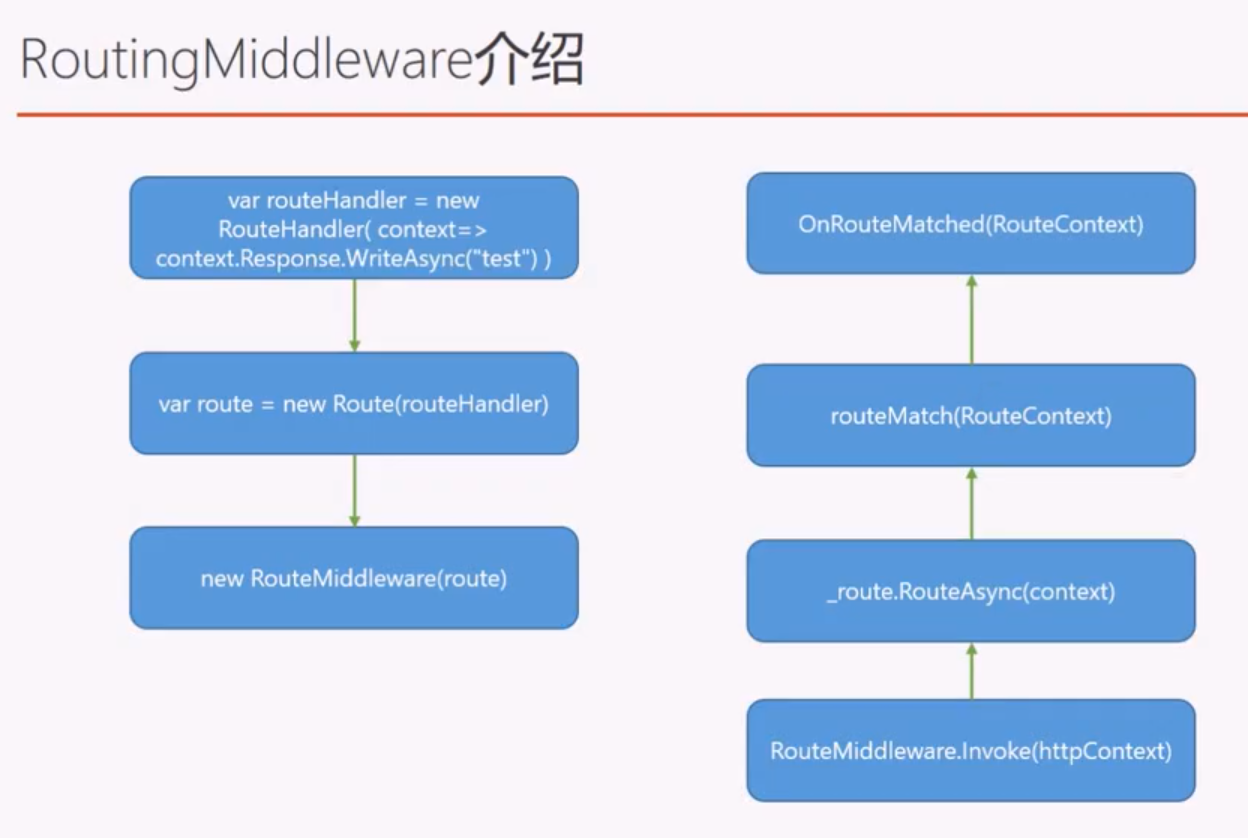
本作品采用知识共享署名-非商业性使用-相同方式共享 4.0 国际许可协议进行许可。
欢迎转载、使用、重新发布,但务必保留文章署名 郑子铭 (包含链接: http://www.cnblogs.com/MingsonZheng/ ),不得用于商业目的,基于本文修改后的作品务必以相同的许可发布。
如有任何疑问,请与我联系 ([email protected]) 。
